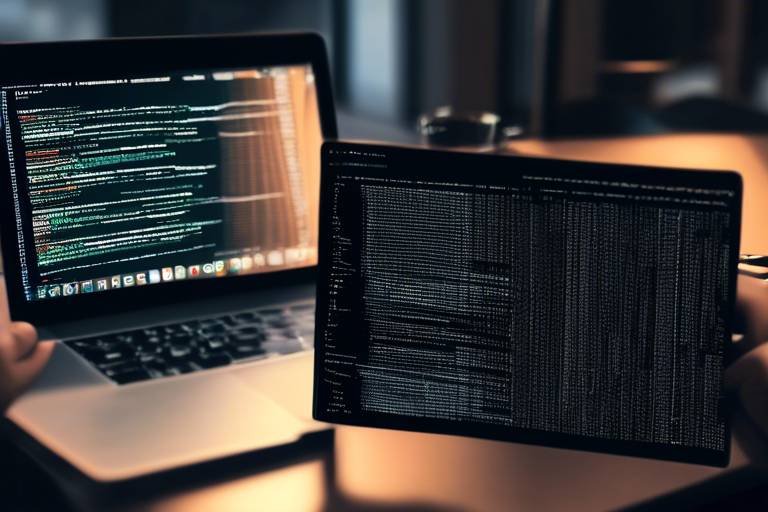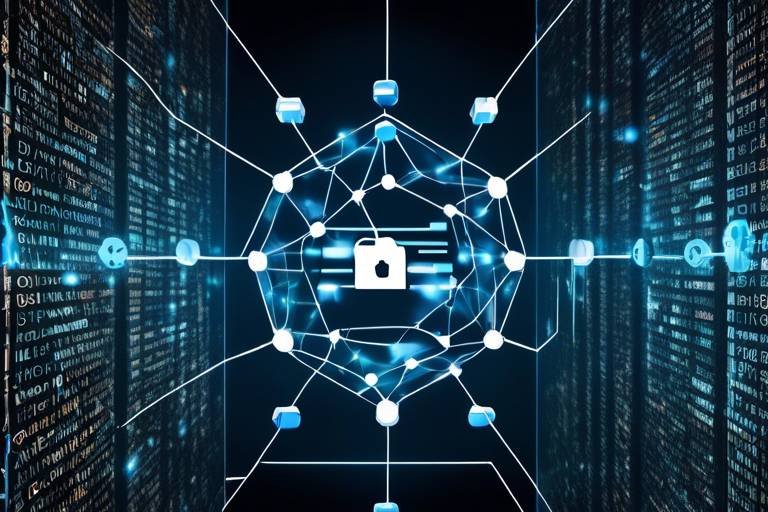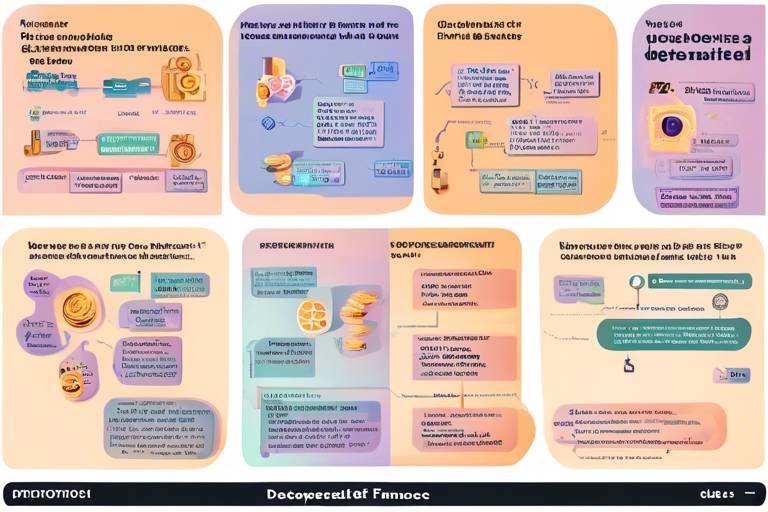The Role of Blockchain in Enhancing Cyber Defense Mechanisms
In today's digital world, where data breaches and cyber threats lurk around every corner, the importance of robust cybersecurity measures cannot be overstated. Blockchain technology, often associated with cryptocurrencies, is emerging as a powerful ally in the fight against cybercrime. By leveraging its decentralized nature, blockchain enhances security protocols, ensures data integrity, and offers innovative solutions to combat the ever-evolving landscape of cyber threats. But how exactly does it do this? Let's dive into the fascinating intersection of blockchain and cybersecurity.
At its core, blockchain is a decentralized ledger technology that stores data across a network of computers, making it nearly impossible for any single entity to alter the information without consensus from the network. This decentralization is a game-changer for cybersecurity, as it eliminates the single point of failure that traditional systems often possess. Instead of relying on a central server, blockchain distributes data across multiple nodes, enhancing both security and transparency. This means that any attempt to tamper with the data would require altering every instance of that data across the network, an almost impossible feat.
As we navigate the digital landscape, cybersecurity professionals face a myriad of challenges. The frequency and sophistication of cyber threats are increasing, with data breaches and ransomware attacks becoming alarmingly common. Organizations are left scrambling to implement more robust defense mechanisms to protect sensitive information. But what are the specific challenges they face?
Data breaches can have devastating consequences for organizations, leading to compromised sensitive information and a tarnished reputation. The fallout from a breach can be extensive, affecting customer trust and loyalty. In fact, studies show that organizations experience an average of $3.86 million in damages from a single data breach. This staggering figure highlights the urgent need for improved security measures to safeguard against these threats.
Cybercriminals employ various tactics to exploit vulnerabilities, resulting in different types of data breaches. Some common methods include:
- Phishing: Deceptive emails that trick users into revealing sensitive information.
- Insider Threats: Employees or contractors exploiting their access to sensitive data.
- Malware Attacks: Malicious software designed to disrupt, damage, or gain unauthorized access to systems.
The financial implications of data breaches extend beyond immediate costs. Organizations face legal fees, regulatory fines, and long-term damage to their brand trust and customer loyalty. In a world where reputation is everything, the cost of a breach can be crippling.
So, how can blockchain technology address these pressing cybersecurity challenges? By providing secure data storage, enhancing authentication processes, and facilitating real-time monitoring of network activities, blockchain presents a formidable solution. Its immutable nature ensures that once data is recorded, it cannot be altered or deleted, providing a reliable audit trail for organizations.
Another fascinating aspect of blockchain is the concept of smart contracts. These self-executing contracts automate and enforce agreements securely, significantly reducing the risk of fraud. Imagine a world where contracts execute automatically when conditions are met, eliminating the need for intermediaries and minimizing human error.
Smart contracts can automate security protocols, ensuring compliance and reducing the chances of human error in implementing cybersecurity measures. This automation not only streamlines processes but also enhances overall security, as it removes the potential for oversight or negligence.
By providing transparent and tamper-proof records of transactions, smart contracts mitigate fraud risks. This level of transparency fosters trust in digital interactions, allowing organizations to confidently engage with customers and partners.
As we look to the future, the potential for blockchain technology to revolutionize cybersecurity is immense. Emerging trends indicate that innovations in blockchain could further enhance cyber defense mechanisms, making it increasingly difficult for cybercriminals to succeed. With ongoing advancements, we can expect to see more organizations adopting blockchain solutions, leading to a safer digital landscape for everyone.
Q: How does blockchain improve cybersecurity?
A: Blockchain enhances cybersecurity by providing a decentralized and tamper-proof system for storing data, making it difficult for cybercriminals to alter or access sensitive information.
Q: What are smart contracts?
A: Smart contracts are self-executing contracts with the terms of the agreement directly written into code, allowing for automated and secure transactions.
Q: Can blockchain completely eliminate cyber threats?
A: While blockchain significantly improves security, it cannot completely eliminate cyber threats. However, it offers innovative solutions that can greatly reduce vulnerabilities.
Q: What industries can benefit from blockchain in cybersecurity?
A: Various industries, including finance, healthcare, and supply chain management, can benefit from blockchain technology to enhance their cybersecurity measures.

Understanding Blockchain Technology
Blockchain technology is often described as a revolutionary force in the digital age, but what exactly does it entail? At its core, blockchain is a decentralized ledger that records transactions across multiple computers. This decentralization means that no single entity has control over the entire chain, creating a level of security and transparency that is hard to achieve with traditional systems. Imagine a digital notebook that everyone can see but no one can alter without consensus; that's the essence of blockchain.
One of the fundamental principles of blockchain is its immutability. Once data is recorded in a block and added to the chain, it cannot be changed or deleted. This characteristic is crucial in applications like cybersecurity, where maintaining the integrity of information is vital. When a transaction is made, it is grouped with others into a block, which is then cryptographically secured and linked to the previous block, forming a chain. This process not only ensures that the data is secure but also that it can be easily audited and verified.
Furthermore, blockchain operates on a consensus mechanism, which is a protocol that considers a transaction valid only when a majority of participants agree on it. This consensus-driven approach significantly reduces the risk of fraud and enhances trust among users. There are various consensus models, including Proof of Work (PoW) and Proof of Stake (PoS), each with its own strengths and weaknesses. For instance, PoW requires participants to solve complex mathematical problems, while PoS allows validators to create new blocks based on the number of coins they hold.
In addition to its security features, blockchain technology offers unparalleled transparency. Each participant in the network has access to the entire ledger, making it easy to trace transactions back to their origin. This transparency is particularly beneficial in sectors like finance and supply chain management, where tracking the movement of assets is critical. By providing a clear and unalterable record of transactions, blockchain can help organizations comply with regulations and build trust with their customers.
To summarize, blockchain technology is a game-changer in enhancing security and transparency in various applications, particularly in the realm of cybersecurity. Its decentralized nature, immutability, consensus mechanisms, and transparency make it a formidable tool in combating cyber threats and ensuring data integrity. As we delve deeper into the challenges faced by cybersecurity professionals, it's essential to understand how these principles can be harnessed to create more robust defense mechanisms.

Cybersecurity Challenges Today
In our fast-paced digital world, cybersecurity challenges are evolving at an alarming rate. As businesses and individuals increasingly rely on technology, the threats lurking in the shadows become more sophisticated and pervasive. Cybercriminals are not just lurking in the dark corners of the internet; they are actively exploiting vulnerabilities in systems, leading to significant concerns for organizations and individuals alike. So, what exactly are these challenges, and how can we navigate through this treacherous landscape?
One of the most pressing issues is the rise of data breaches. These breaches occur when unauthorized individuals gain access to sensitive information, often resulting in severe consequences for the affected parties. The fallout from a data breach can be catastrophic, ranging from financial losses to irreparable damage to an organization’s reputation. In fact, a report by IBM found that the average cost of a data breach is around $4.24 million. This staggering figure highlights the urgent need for more robust security measures.
Moreover, the threat of ransomware attacks has surged in recent years. Cybercriminals employ this tactic by encrypting critical data and demanding a ransom for its release. These attacks can paralyze entire organizations, leading to operational downtime and significant financial losses. In some cases, companies are forced to pay the ransom to regain access to their own data, further fueling the cycle of crime.
Another significant challenge is the increasing complexity of cybersecurity threats. Cybercriminals are constantly developing new methods to breach security systems, making it difficult for organizations to keep up. For example, phishing attacks have become more sophisticated, often appearing as legitimate communications from trusted sources. This tactic exploits human psychology, tricking individuals into revealing sensitive information. As a result, employees must remain vigilant and educated about these threats, but human error is always a possibility.
To truly grasp the magnitude of these challenges, let's delve into the different types of data breaches that organizations face:
- Phishing: Deceptive emails or messages designed to trick users into providing personal information.
- Insider Threats: Employees or contractors who misuse their access to sensitive information.
- Malware Attacks: Malicious software designed to disrupt, damage, or gain unauthorized access to systems.
Each of these methods presents unique challenges, and organizations must develop comprehensive strategies to address them. The cost of ignoring these threats can be astronomical, not just in terms of immediate financial impact but also in long-term damage to brand trust and customer loyalty. The aftermath of a data breach can lead to a significant drop in customer confidence, which can take years to rebuild.
As we continue to navigate this digital frontier, it becomes increasingly clear that cybersecurity is not just an IT issue; it’s a critical business concern that requires the attention of every level of an organization. With the stakes so high, it’s essential for businesses to adopt a proactive approach to cybersecurity, investing in advanced technologies and cultivating a culture of security awareness among employees.
In summary, the cybersecurity landscape is fraught with challenges that can have devastating effects on organizations and individuals alike. From data breaches to ransomware attacks, the threats are real and ever-evolving. By understanding these challenges and taking proactive measures, organizations can better prepare themselves to defend against the onslaught of cyber threats.
Q: What is a data breach?
A: A data breach occurs when unauthorized individuals gain access to sensitive information, potentially leading to financial loss and reputational damage.
Q: How can organizations protect themselves from ransomware attacks?
A: Organizations can protect themselves by regularly backing up data, implementing strong security protocols, and educating employees about phishing and other cyber threats.
Q: What role do employees play in cybersecurity?
A: Employees are often the first line of defense against cyber threats. Their awareness and vigilance can significantly reduce the risk of data breaches and other attacks.

Data Breaches and Their Impact
In today's hyper-connected world, data breaches have become alarmingly common, striking fear into businesses and individuals alike. The term "data breach" refers to an incident where unauthorized access to sensitive data occurs, often leading to the exposure of personal information, financial records, and confidential business data. The impact of these breaches can be devastating, not just for the immediate victims but also for the broader ecosystem of trust that underpins our digital interactions. Imagine waking up to find that your private information has been compromised; the emotional and financial toll can be overwhelming.
One of the most significant consequences of data breaches is the erosion of trust. When customers feel that their data is not secure, they are likely to take their business elsewhere. Companies like Equifax and Target have faced severe backlash after high-profile breaches, losing millions in revenue and suffering long-term damage to their brand reputation. In fact, a recent study revealed that over 70% of consumers would stop doing business with a company that has experienced a data breach. This statistic underscores the critical need for organizations to bolster their cybersecurity measures.
Moreover, the financial implications of data breaches can be staggering. According to the 2023 Cost of a Data Breach Report by IBM, the average cost of a data breach is now estimated to be around $4.35 million. This figure includes direct costs such as legal fees, remediation efforts, and regulatory fines, as well as indirect costs like lost business opportunities and reputational damage. To put this into perspective, consider the following breakdown of costs associated with a typical data breach:
| Cost Category | Average Cost |
|---|---|
| Legal Fees | $1.5 million |
| Remediation Efforts | $1.2 million |
| Regulatory Fines | $800,000 |
| Loss of Business | $1 million |
These numbers paint a grim picture, but they also highlight the urgent need for organizations to invest in robust cybersecurity measures. The reality is that cybercriminals are becoming increasingly sophisticated, employing various tactics to exploit vulnerabilities. From phishing scams that trick employees into revealing sensitive information to malware attacks that infiltrate systems, the methods are as diverse as they are dangerous. In fact, a recent report indicated that over 60% of breaches are attributed to human error, emphasizing the need for comprehensive training and awareness programs.
In conclusion, the impact of data breaches extends far beyond immediate financial losses. They can damage reputations, erode customer trust, and lead to long-lasting repercussions for organizations. As we navigate this digital landscape, it’s crucial for businesses to prioritize cybersecurity, not just as a protective measure, but as a fundamental component of their operational strategy. After all, in a world where data is the new currency, safeguarding that data is paramount.
- What is a data breach? A data breach is an incident where unauthorized access to sensitive data occurs, often leading to the exposure of personal or confidential information.
- What are the common causes of data breaches? Common causes include phishing attacks, malware, insider threats, and human error.
- How can organizations prevent data breaches? Organizations can prevent data breaches by implementing robust cybersecurity measures, conducting regular training for employees, and using advanced encryption technologies.
- What should individuals do if they are affected by a data breach? Individuals should monitor their financial accounts, change passwords, and consider identity theft protection services.

Types of Data Breaches
In the vast and complex world of cybersecurity, data breaches come in many shapes and sizes, each posing unique threats to individuals and organizations alike. Understanding the different types of data breaches is crucial for developing effective defense strategies. Essentially, a data breach occurs when unauthorized parties gain access to sensitive data, which can include anything from personal identification information to corporate secrets. This intrusion can happen in various ways, and recognizing these methods is the first step in fortifying our defenses.
One of the most common types of data breaches is phishing. This technique involves tricking individuals into revealing their confidential information, usually through deceptive emails or messages that appear to be from trusted sources. Imagine receiving an email that looks like it’s from your bank, asking you to verify your account details. If you fall for it, you may inadvertently hand over your credentials to cybercriminals. Phishing attacks have become increasingly sophisticated, making it essential for users to remain vigilant and informed.
Another significant threat comes from insider threats. These breaches occur when individuals within an organization, such as employees or contractors, misuse their access to sensitive data. This could be intentional, such as stealing trade secrets, or unintentional, like accidentally sending confidential information to the wrong person. Insider threats are particularly challenging to combat because they often come from trusted sources, making it difficult to identify and mitigate the risk before damage is done.
Malware attacks also represent a prevalent form of data breach. Malware, short for malicious software, includes viruses, worms, and ransomware that infiltrate systems to steal or corrupt data. Ransomware, in particular, has garnered attention for its devastating effects, as it encrypts an organization’s data and demands payment for its release. Organizations must invest in robust security measures to protect against these insidious threats, as they can lead to significant downtime and financial loss.
To further illustrate the diversity of data breaches, here’s a quick overview of some additional types:
- Credential stuffing: This occurs when attackers use stolen usernames and passwords from one breach to access accounts on different platforms.
- Physical breaches: This involves unauthorized physical access to sensitive data, such as stealing a laptop or accessing a server room.
- Third-party breaches: These happen when a partner or vendor with access to your data suffers a breach, compromising your information in the process.
Each type of data breach presents its own set of challenges, and the consequences can be devastating. Organizations must not only focus on preventing these breaches but also on developing comprehensive response plans to mitigate damage when they occur. By understanding the various tactics employed by cybercriminals, businesses can better prepare themselves to safeguard sensitive information and maintain trust with their customers.
What is a data breach?
A data breach is an incident where unauthorized individuals gain access to sensitive, protected, or confidential data, often resulting in its theft or exposure.
What are the common causes of data breaches?
Common causes include phishing attacks, malware infections, insider threats, and poor security practices, such as weak passwords or unpatched software.
How can organizations prevent data breaches?
Organizations can prevent breaches by implementing strong security protocols, conducting regular training for employees, and employing advanced technologies like encryption and multi-factor authentication.
What should I do if I suspect a data breach?
If you suspect a data breach, you should immediately inform your organization's IT department, change your passwords, and monitor your accounts for any suspicious activity.

Cost of Data Breaches
The financial impact of data breaches is staggering and can wreak havoc on organizations of all sizes. When we talk about the , we’re not just referring to the immediate expenses incurred; it’s a complex web of direct and indirect costs that can linger for years. According to recent studies, the average cost of a data breach can reach into the millions, with the global average pegged at around $4.35 million. This figure can vary significantly based on the size of the organization, the nature of the breach, and the industry affected.
Direct costs include expenses related to investigation, notification, and remediation. Organizations often need to hire cybersecurity experts to assess the damage and patch vulnerabilities. Furthermore, they may face legal fees as they navigate the aftermath of a breach, especially if sensitive customer data is compromised. This can lead to hefty fines and penalties from regulatory bodies, further inflating the costs.
However, the indirect costs can be even more damaging. Consider the long-term effects on brand reputation; a single breach can erode customer trust and loyalty. Customers may feel hesitant to share personal information or conduct transactions with a company that has suffered a breach, leading to a decrease in sales and revenue. The loss of business can be profound, as acquiring new customers often costs much more than retaining existing ones.
Moreover, organizations may find themselves in a position where they have to invest significantly in marketing and public relations efforts to rebuild their reputation. This can result in an extended period of financial strain, as companies scramble to regain the trust of their customers. According to studies, organizations can expect to see a 20% decline in customer retention after a data breach, which can severely impact long-term profitability.
To illustrate the multifaceted nature of these costs, let’s take a look at a breakdown of potential expenses:
| Type of Cost | Description | Estimated Cost |
|---|---|---|
| Investigation Costs | Hiring cybersecurity experts to analyze the breach. | $200,000 |
| Legal Fees | Costs associated with legal representation and fines. | $500,000 |
| Customer Notification | Expenses related to informing affected customers. | $150,000 |
| Reputation Management | Marketing efforts to restore brand image. | $300,000 |
| Loss of Business | Projected decline in revenue post-breach. | $1,000,000+ |
In summary, the extends far beyond the immediate financial implications. Organizations must consider the long-term effects on their operations, customer relationships, and overall market position. With the increasing frequency of cyberattacks, investing in robust cybersecurity measures is no longer optional; it’s a necessity for survival in today’s digital landscape.
- What is the average cost of a data breach? The average cost of a data breach is approximately $4.35 million, but this can vary widely depending on several factors.
- How do data breaches affect customer trust? Data breaches can lead to a significant loss of customer trust, often resulting in a 20% decline in customer retention.
- What are the main types of costs associated with a data breach? Costs can be categorized into direct costs like investigation and legal fees, and indirect costs such as reputation management and loss of business.

Blockchain Solutions for Cybersecurity
As we navigate through an era where cyber threats loom larger than ever, the urgency for robust cybersecurity solutions is palpable. Enter blockchain technology, a revolutionary force that is not just a buzzword but a viable solution to many of the challenges facing cybersecurity today. Imagine a world where data integrity is not just a goal but a guarantee. Blockchain, with its decentralized nature and cryptographic security, offers just that. By creating a tamper-proof ledger, it ensures that data remains unaltered and trustworthy, making it a formidable ally in the fight against cybercrime.
One of the most compelling aspects of blockchain is its ability to provide secure data storage. Traditional databases are centralized, making them prime targets for hackers. In contrast, blockchain distributes data across a network of nodes, meaning there’s no single point of failure. If one node is compromised, the rest remain intact, preserving the integrity of the entire system. This decentralized approach not only enhances security but also boosts transparency. Every transaction is recorded on the blockchain, creating an immutable audit trail that can be invaluable during security assessments and investigations.
Moreover, blockchain enhances authentication processes, a critical component in cybersecurity. By utilizing cryptographic methods, blockchain can confirm identities and transactions without the need for a central authority. This decentralized authentication reduces the risk of identity theft and unauthorized access, which are prevalent in today’s digital landscape. Instead of relying on traditional usernames and passwords, which can be easily compromised, blockchain can use digital signatures and public-private key pairs to ensure that only authorized users gain access to sensitive data.
Furthermore, blockchain facilitates real-time monitoring of network activities. With its ability to record transactions as they happen, organizations can quickly identify and respond to suspicious activities. This proactive approach is crucial in a world where cyber threats evolve rapidly and can cause significant damage in a short amount of time. By analyzing blockchain data, cybersecurity teams can detect anomalies and respond to potential threats before they escalate into full-blown attacks.
To illustrate the potential of blockchain in cybersecurity, consider the following table that outlines key benefits:
| Blockchain Benefit | Description |
|---|---|
| Decentralization | Eliminates single points of failure, enhancing overall security. |
| Data Integrity | Ensures data remains unaltered through cryptographic methods. |
| Enhanced Authentication | Utilizes digital signatures for secure user verification. |
| Real-time Monitoring | Allows for immediate detection of suspicious activities. |
In conclusion, blockchain technology offers a suite of solutions that can significantly bolster cybersecurity efforts. Its inherent features not only address existing vulnerabilities but also pave the way for innovative security practices that can adapt to the ever-evolving cyber threat landscape. As organizations continue to grapple with data breaches and malicious attacks, embracing blockchain could very well be the key to a more secure digital future.
- What is blockchain technology? Blockchain is a decentralized digital ledger that records transactions across multiple computers, ensuring that the data cannot be altered retroactively.
- How does blockchain enhance cybersecurity? By decentralizing data storage, enhancing authentication processes, and providing real-time monitoring, blockchain significantly reduces the risk of cyber threats.
- Can blockchain prevent data breaches? While it cannot eliminate all risks, blockchain's tamper-proof nature and transparency can greatly reduce the likelihood and impact of data breaches.
- What are smart contracts? Smart contracts are self-executing contracts with the terms of the agreement directly written into code, which can automate and secure various processes.

Smart Contracts and Security
In the ever-evolving world of technology, smart contracts have emerged as a revolutionary tool that enhances security in various sectors, particularly in cybersecurity. So, what exactly are smart contracts? Imagine them as digital agreements that automatically execute when predefined conditions are met. This automation not only streamlines processes but also significantly reduces the risk of human error, which is often a weak point in traditional security protocols.
One of the most compelling features of smart contracts is their tamper-proof nature. Once a smart contract is deployed on the blockchain, it becomes nearly impossible to alter or delete it without consensus from all parties involved. This characteristic is crucial in a world where cyber threats are rampant, as it ensures that agreements are honored and cannot be manipulated by malicious actors. For instance, in a financial transaction, a smart contract can automatically release funds only when all conditions are verified, eliminating the need for intermediaries and thus reducing points of vulnerability.
Furthermore, the integration of smart contracts in cybersecurity protocols can lead to a more secure environment through real-time monitoring. By utilizing blockchain's decentralized ledger, organizations can track all transactions and interactions, creating a transparent and immutable record. This visibility allows for immediate detection of any irregularities or unauthorized access attempts, enabling quicker responses to potential threats. In a sense, smart contracts act like vigilant security guards, always on the lookout for suspicious activity.
Let’s delve deeper into how smart contracts can automate security protocols. By embedding security measures directly into the contract code, organizations can ensure compliance with regulations and standards without relying solely on manual processes. For example, a smart contract could be programmed to automatically enforce access controls based on user roles. If someone attempts to access sensitive data without the appropriate permissions, the smart contract would deny access instantaneously, thereby preventing potential breaches.
Additionally, smart contracts can significantly reduce fraud risks. In traditional transactions, trust is often placed in third parties, which can lead to vulnerabilities. However, smart contracts operate on a principle of transparency and trustlessness. Each transaction is recorded on the blockchain, allowing all parties to verify the authenticity of the interactions. This level of transparency not only builds trust among users but also acts as a deterrent against fraudulent activities. With a tamper-proof record of all transactions, the chances of disputes or fraud are minimized, creating a safer digital landscape.
In conclusion, the integration of smart contracts into cybersecurity frameworks represents a significant leap forward in enhancing security measures. By automating processes, providing transparent records, and reducing reliance on human intervention, smart contracts offer robust solutions to combat the ever-growing cyber threats. As we continue to navigate this digital age, embracing such innovations will be crucial in fortifying our defenses against cyber adversaries.
- What are smart contracts? Smart contracts are self-executing contracts with the terms of the agreement directly written into code, allowing for automated and secure transactions.
- How do smart contracts enhance security? They provide tamper-proof records, automate compliance, and reduce human error, making them a powerful tool against cyber threats.
- Can smart contracts prevent fraud? Yes, their transparent and immutable nature helps minimize the risk of fraud by ensuring all transactions are verifiable and secure.
- Are smart contracts easy to implement? While they require initial setup and coding, once deployed, they operate autonomously, streamlining processes and enhancing security.

Automating Security Protocols
In an era where cyber threats are evolving at lightning speed, the need for robust security measures has never been more critical. One of the most promising solutions lies in the automation of security protocols through blockchain technology. Imagine a world where security measures are not only implemented but also continuously monitored and adjusted in real-time. This is the power of automation, and blockchain is at the forefront of this revolution.
Automating security protocols means that organizations can reduce the reliance on human intervention, which is often a source of error and inconsistency. By leveraging smart contracts, businesses can ensure that security policies are enforced automatically. For instance, if a network anomaly is detected, the smart contract can trigger predefined responses, such as isolating affected systems or alerting security personnel. This immediacy is crucial in preventing potential breaches before they escalate.
Moreover, automation can significantly enhance compliance with regulations and standards. In many industries, organizations are required to adhere to strict guidelines regarding data protection and privacy. Manually tracking compliance can be labor-intensive and prone to oversight. However, with blockchain, compliance can be built into the smart contracts themselves. These contracts can automatically verify whether the necessary security measures are in place, ensuring that organizations stay ahead of regulatory requirements.
Consider this: when a company implements automated security protocols, it can lead to a more streamlined and efficient operation. Instead of spending countless hours on manual checks and audits, security teams can focus their efforts on strategic initiatives that enhance overall cybersecurity posture. This not only saves time and resources but also fosters a proactive security culture within the organization.
To illustrate the impact of automation in security protocols, let's take a look at the following table that outlines the benefits:
| Benefit | Description |
|---|---|
| Increased Efficiency | Automated systems can operate 24/7 without downtime, allowing for continuous monitoring and response. |
| Reduced Human Error | Minimizing human intervention leads to fewer mistakes in the implementation of security measures. |
| Cost Savings | Automation reduces the need for extensive manual labor, ultimately lowering operational costs. |
| Enhanced Compliance | Smart contracts can ensure that all security protocols meet regulatory standards automatically. |
In conclusion, automating security protocols through blockchain technology is not just a trend; it’s a necessity in today’s digital landscape. Organizations that embrace this innovation will not only bolster their defenses against cyber threats but also position themselves as leaders in cybersecurity. With the ability to respond swiftly and accurately to threats, the future of cybersecurity looks promising, and automation will undoubtedly play a pivotal role in shaping that future.
- What are automated security protocols? Automated security protocols refer to the use of technology, such as blockchain and smart contracts, to enforce and monitor security measures without human intervention.
- How does blockchain enhance security? Blockchain enhances security by providing a decentralized and tamper-proof ledger that records all transactions and changes, making it difficult for cybercriminals to alter data.
- Can automation reduce costs in cybersecurity? Yes, automation can significantly reduce costs by minimizing the need for manual labor and allowing security teams to focus on more strategic tasks.
- What role do smart contracts play in cybersecurity? Smart contracts automate the enforcement of security policies and can trigger actions based on specific criteria, enhancing overall security measures.

Reducing Fraud Risks
In today's digital age, fraud is a pervasive threat that can cripple businesses and erode trust between consumers and service providers. Imagine walking into a store, only to find that your credit card information has been compromised, or worse, someone has taken out a loan in your name. This scenario is all too real for many individuals and organizations. However, the advent of blockchain technology offers a powerful antidote to these burgeoning risks. By leveraging its inherent properties of transparency and immutability, blockchain can significantly reduce fraud risks and enhance the security of digital transactions.
At its core, blockchain operates as a decentralized ledger, meaning that once data is recorded, it cannot be altered or deleted without the consensus of the network participants. This characteristic is crucial in combating fraud because it creates a tamper-proof record of transactions. For instance, if a company uses blockchain to record its financial transactions, any attempt to manipulate those records would be immediately evident to all parties involved. This level of transparency not only deters fraudulent activities but also instills confidence among customers and partners.
Furthermore, smart contracts—self-executing contracts with the terms of the agreement directly written into code—play a pivotal role in minimizing fraud. These contracts automatically enforce the terms agreed upon by both parties, ensuring that conditions are met before any transaction takes place. For example, if a service provider fails to deliver on their promise, the smart contract can automatically trigger a refund without any manual intervention. This not only reduces the chances of fraud but also enhances operational efficiency.
To illustrate the impact of blockchain on fraud reduction, consider the following table that summarizes key benefits:
| Benefit | Description |
|---|---|
| Transparency | All transactions are visible to authorized participants, making it easy to track and verify information. |
| Immutability | Once recorded, data cannot be changed or deleted, reducing the risk of tampering. |
| Smart Contracts | Automated agreements that execute when conditions are met, minimizing human error and fraud. |
| Decentralization | No single point of failure, making it harder for fraudsters to manipulate the system. |
Moreover, the integration of blockchain technology can facilitate enhanced identity verification processes. Traditional methods of identity verification often involve multiple steps and can be vulnerable to hacking. In contrast, blockchain can store identity information securely and allow users to control access to it. This means that individuals can share their identity information selectively, reducing the risk of identity theft. For example, a user could provide a potential lender with access to only the necessary details for a loan application, without exposing their entire identity.
In conclusion, the potential of blockchain to reduce fraud risks is profound. By providing a transparent, immutable, and decentralized framework for transactions, it not only minimizes opportunities for fraud but also fosters a greater sense of trust in digital interactions. As organizations increasingly adopt this technology, we can expect to see a significant decline in fraudulent activities, paving the way for a more secure digital landscape.
- What is blockchain technology? Blockchain is a decentralized digital ledger that records transactions across many computers, ensuring that the recorded transactions cannot be altered retroactively.
- How does blockchain reduce fraud? By creating a transparent and tamper-proof record of transactions, blockchain makes it difficult for fraudsters to manipulate data.
- What are smart contracts? Smart contracts are self-executing contracts with the terms of the agreement directly written into code, which automatically enforce and execute agreements when conditions are met.
- Can blockchain be used for identity verification? Yes, blockchain can securely store identity information, allowing users to control access to their data and reduce the risk of identity theft.

Future Trends in Blockchain and Cybersecurity
As we gaze into the crystal ball of technology, the intersection of blockchain and cybersecurity reveals a landscape ripe with potential. The synergy between these two fields is not just a fleeting trend; it represents a paradigm shift that could redefine how we secure our digital environments. With cyber threats evolving at a breakneck pace, the future of cybersecurity will be heavily influenced by advancements in blockchain technology. But what does this really mean for organizations and individuals alike?
One of the most exciting prospects is the emergence of decentralized identity solutions. Imagine a world where individuals control their own digital identities, free from the clutches of centralized databases that are often targeted by hackers. Blockchain can facilitate this by allowing users to create cryptographically secure identities that are verified through a network rather than a single entity. This not only enhances security but also empowers users, giving them more control over their personal information.
Moreover, the integration of artificial intelligence (AI) with blockchain is another trend to watch. AI can analyze vast amounts of data to identify patterns and anomalies that might indicate a cyber threat. When combined with the immutable nature of blockchain, organizations can create a more robust defense mechanism. For instance, if an AI system detects a potential breach, it could automatically trigger a blockchain-based protocol to secure affected data, ensuring that any unauthorized access is logged and cannot be altered.
Furthermore, the rise of quantum computing poses both challenges and opportunities for cybersecurity. Quantum computers have the potential to break traditional encryption methods, which raises concerns about data security. However, blockchain can play a crucial role in developing quantum-resistant algorithms. By leveraging the unique properties of blockchain, we can create a new standard for encryption that is resilient to the capabilities of quantum computers, thus safeguarding sensitive information for the future.
To illustrate the potential impact of these trends, let's take a look at a table summarizing the key areas where blockchain is expected to enhance cybersecurity:
| Trend | Description | Potential Impact |
|---|---|---|
| Decentralized Identity Solutions | Empowers users to control their digital identities using blockchain. | Increased security and privacy for individuals. |
| AI Integration | Combines AI's analytical power with blockchain's security. | Proactive threat detection and automated response. |
| Quantum-Resistant Algorithms | Develops new encryption standards resistant to quantum attacks. | Long-term data security and integrity. |
As we look ahead, it's clear that the future of cybersecurity will be shaped by these and other innovations. However, it's important to remember that technology alone won't solve all our problems. The human element remains critical—organizations must foster a culture of cybersecurity awareness and continuous learning to complement these technological advancements. Training employees to recognize the signs of cyber threats and encouraging a proactive approach to security will be essential as we navigate this ever-evolving landscape.
In conclusion, the fusion of blockchain and cybersecurity is not merely a trend; it's a fundamental shift that will redefine how we protect our digital assets. With innovations on the horizon and a commitment to harnessing these technologies, we can look forward to a future where our online interactions are significantly more secure.
- What is blockchain technology?
Blockchain is a decentralized digital ledger that records transactions across many computers, ensuring that the recorded transactions cannot be altered retroactively. - How can blockchain enhance cybersecurity?
Blockchain enhances cybersecurity by providing secure data storage, enabling decentralized identity management, and allowing for real-time monitoring of network activities. - What are smart contracts?
Smart contracts are self-executing contracts with the terms of the agreement directly written into code, which are stored and executed on the blockchain. - What role does AI play in cybersecurity?
AI can analyze data to identify potential threats and automate responses, making cybersecurity measures more efficient and effective.
Frequently Asked Questions
- What is blockchain technology?
Blockchain technology is a decentralized digital ledger that records transactions across multiple computers. This ensures that the recorded transactions cannot be altered retroactively, enhancing security and transparency in various applications, including cybersecurity.
- How does blockchain enhance cybersecurity?
Blockchain enhances cybersecurity by providing secure data storage, improving authentication processes, and enabling real-time monitoring of network activities. Its decentralized nature makes it harder for cybercriminals to manipulate or corrupt data.
- What are the main cybersecurity challenges today?
Today's cybersecurity challenges include data breaches, ransomware attacks, and the need for more robust defense mechanisms. As technology evolves, so do the tactics employed by cybercriminals, making it essential for organizations to stay ahead of these threats.
- What types of data breaches are most common?
Common types of data breaches include phishing attacks, insider threats, and malware infections. Each of these tactics exploits different vulnerabilities, highlighting the need for comprehensive cybersecurity strategies.
- What is the impact of data breaches on organizations?
Data breaches can have severe consequences for organizations, including financial losses, legal fees, and long-term damage to their reputation. The fallout can lead to a loss of customer trust and loyalty, making it crucial for companies to implement effective security measures.
- How do smart contracts improve cybersecurity?
Smart contracts automate and enforce agreements securely, reducing the risk of fraud and human error. By providing transparent and tamper-proof records of transactions, they enhance trust in digital interactions and streamline security protocols.
- What are the future trends in blockchain and cybersecurity?
Future trends in blockchain and cybersecurity include increased integration of AI for threat detection, advancements in decentralized identity management, and the development of more sophisticated smart contracts. These innovations will further enhance cyber defense mechanisms.



















